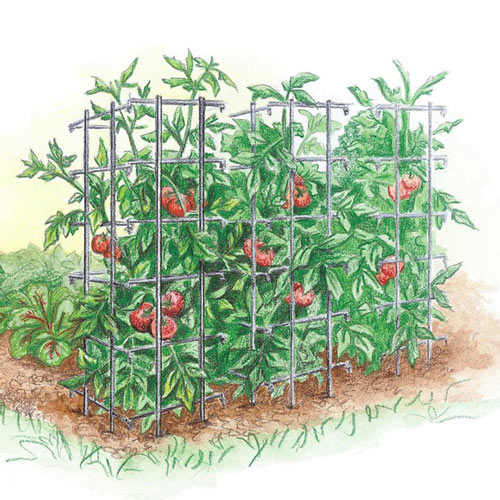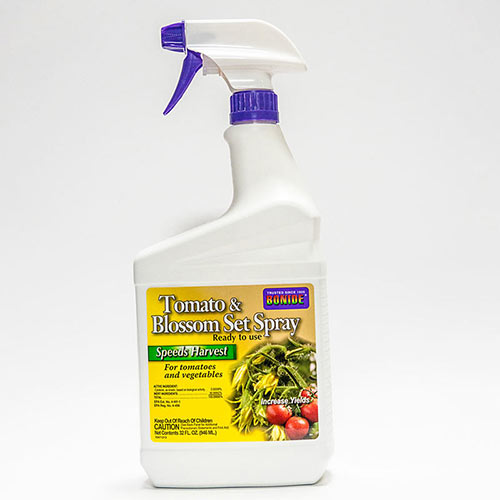Stages of Tomato Ripening and When to Pick Them
-
Helpful Products from Gardens Alive!
-
 Tomato Cage - Plant Trellis
Tomato Cage - Plant Trellis -
 Tomato & Blossom Set Spray
Tomato & Blossom Set Spray
Q: I've been hearing you talk about tomatoes splitting as a response to heavy rain following dry times. Does this debunk the theory that the fruits stop taking in nutrition after ripening has started? I had always heard that the first break in color signaled that abscission had occurred and the fruit had been cut off from receiving additional nutrition from the main plant. If tomatoes that are ripening split after a heavy rain, does this mean that they are not completely abscised from the plant? On another note, what's your take on picking tomatoes at the first signs of ripening vs waiting a little longer? The mockingbirds (our state bird down here in Texas) are killing me when I try to wait.
John in Texas ("zone 9A; southwest of Houston")
A: Mocked by mockingbirds; how poetic. At any rate, I have long told gardeners that once a tomato starts to color up, it's no longer taking nutrition from the vine and can be removed to ripen up completely indoors. But it has been a long time since I double checked the research on this suggestion, so I went back to my original source—an excellent article we published about tomato ripening in ORGANIC GARDENING magazine during my time as Editor-in-Chief; when everything in every article was rigorously and independently researched and fact checked.
…And found therein a perfect explanation of the tomato ripening process in a story co-written by our then Managing Editor Vicki Mattern and regular old editor Scott Meyer (who is now Editorial Director for "Grow", the magazine that members of the Pennsylvania Horticultural Society receive as one of their many benefits, which also include special tickets to the Philadelphia Flower Show!).
Now, and I quote: "tomatoes have two distinct growth phases: cell division and cell enlargement. Shortly after the flower is pollinated, the tomato feverishly produces and reproduces cells. After a few weeks, the peak number of cells is reached and each individual cell begins to grow larger. This process eventually reaches its peak as the "immature green" tomato reaches its final size.
Then it starts to ripen. The fruit will slowly lose the green color of its chlorophyll as the carotenoids and lycopene that give it its final colors begin to develop. Most ripening tomatoes will go from a deep green to a lighter green, then almost yellow. Tomatoes that are destined to be red when ripe will first develop a few pink streaks down at the blossom end, while tomatoes that are destined to be yellow when ripe will begin by becoming a brighter shade of yellow.
These tomatoes are at what's called "the breaker stage". And tomatoes that have reached the breaker stage will finish ripening up off the vine with full flavor or close to it—as long as you don't screw it up.
One way to ruin things is to put the tomatoes in "a sunny windowsill". I've been warning people about this for the past 26 years: only the leaves of the plants need sun, not the fruits. In fact, placing your ripening tomatoes in direct sun can cook the flavor right out of them. The same thing happens if you don't pick ripe tomatoes promptly outdoors; they can lose a lot of flavor sitting out on the vine once they're dead ripe.
The other extreme to avoid is a chill. A Food Scientist at the University of Maryland quoted in that OG story warned that ripening tomatoes will taste mealy and have little flavor if they're exposed to temps below 55 degrees F. The ideal temperature for ripening breaker tomatoes indoors, we are told, is between 60 and 65 degrees. That's why you should never put any tomatoes in the fridge. Ever ever ever!
Now: our listener uses the word "abscission"; what does THAT mean?
Specifically, when something becomes physically disconnected from something else; as when a fruit is picked or falls from a plant, a branch is pruned; or in humans, circumcision, when…
Enough! Enough! We get it!
It's a word you see in a lot in heavy-duty horticultural articles about tomatoes. Our listener is using it in a more theoretical sense, following the concept that a ripening tomato is no longer 'attached' to the plant in the sense that it's not absorbing any more nutrients. And if that lack of absorption theory is correct, why would a 'breaker tomato' split if it hasn't already.
I had to swim through some of the most intense scientific research I've ever tried to read to come to this conclusion, but it seems that the reverse is true. Because the ripening tomato is no longer actively taking in nutrients, excess water comes through unimpeded and may actually lead to worse splitting. And pruning tomato plants—this bizarre concept of removing healthy branches and leaves—leads to worse splitting because there's less biomass for the excess water to go into.
(This is one of those 'easy questions' that had me reading footnotes and citations all day. You'd think I'd learn.)
Anyway—everyone agrees that tomatoes that have turned color and are actively ripening can be taken off the vine and brought inside, where they should achieve full flavor if kept out of direct sunshine in an area that stays around 65 degrees.
And no more 'easy questions' from now on!
John in Texas ("zone 9A; southwest of Houston")
A: Mocked by mockingbirds; how poetic. At any rate, I have long told gardeners that once a tomato starts to color up, it's no longer taking nutrition from the vine and can be removed to ripen up completely indoors. But it has been a long time since I double checked the research on this suggestion, so I went back to my original source—an excellent article we published about tomato ripening in ORGANIC GARDENING magazine during my time as Editor-in-Chief; when everything in every article was rigorously and independently researched and fact checked.
…And found therein a perfect explanation of the tomato ripening process in a story co-written by our then Managing Editor Vicki Mattern and regular old editor Scott Meyer (who is now Editorial Director for "Grow", the magazine that members of the Pennsylvania Horticultural Society receive as one of their many benefits, which also include special tickets to the Philadelphia Flower Show!).
Now, and I quote: "tomatoes have two distinct growth phases: cell division and cell enlargement. Shortly after the flower is pollinated, the tomato feverishly produces and reproduces cells. After a few weeks, the peak number of cells is reached and each individual cell begins to grow larger. This process eventually reaches its peak as the "immature green" tomato reaches its final size.
Then it starts to ripen. The fruit will slowly lose the green color of its chlorophyll as the carotenoids and lycopene that give it its final colors begin to develop. Most ripening tomatoes will go from a deep green to a lighter green, then almost yellow. Tomatoes that are destined to be red when ripe will first develop a few pink streaks down at the blossom end, while tomatoes that are destined to be yellow when ripe will begin by becoming a brighter shade of yellow.
These tomatoes are at what's called "the breaker stage". And tomatoes that have reached the breaker stage will finish ripening up off the vine with full flavor or close to it—as long as you don't screw it up.
One way to ruin things is to put the tomatoes in "a sunny windowsill". I've been warning people about this for the past 26 years: only the leaves of the plants need sun, not the fruits. In fact, placing your ripening tomatoes in direct sun can cook the flavor right out of them. The same thing happens if you don't pick ripe tomatoes promptly outdoors; they can lose a lot of flavor sitting out on the vine once they're dead ripe.
The other extreme to avoid is a chill. A Food Scientist at the University of Maryland quoted in that OG story warned that ripening tomatoes will taste mealy and have little flavor if they're exposed to temps below 55 degrees F. The ideal temperature for ripening breaker tomatoes indoors, we are told, is between 60 and 65 degrees. That's why you should never put any tomatoes in the fridge. Ever ever ever!
Now: our listener uses the word "abscission"; what does THAT mean?
Specifically, when something becomes physically disconnected from something else; as when a fruit is picked or falls from a plant, a branch is pruned; or in humans, circumcision, when…
Enough! Enough! We get it!
It's a word you see in a lot in heavy-duty horticultural articles about tomatoes. Our listener is using it in a more theoretical sense, following the concept that a ripening tomato is no longer 'attached' to the plant in the sense that it's not absorbing any more nutrients. And if that lack of absorption theory is correct, why would a 'breaker tomato' split if it hasn't already.
I had to swim through some of the most intense scientific research I've ever tried to read to come to this conclusion, but it seems that the reverse is true. Because the ripening tomato is no longer actively taking in nutrients, excess water comes through unimpeded and may actually lead to worse splitting. And pruning tomato plants—this bizarre concept of removing healthy branches and leaves—leads to worse splitting because there's less biomass for the excess water to go into.
(This is one of those 'easy questions' that had me reading footnotes and citations all day. You'd think I'd learn.)
Anyway—everyone agrees that tomatoes that have turned color and are actively ripening can be taken off the vine and brought inside, where they should achieve full flavor if kept out of direct sunshine in an area that stays around 65 degrees.
And no more 'easy questions' from now on!
-
Helpful Products from Gardens Alive!
-
 Tomato Cage - Plant Trellis
Tomato Cage - Plant Trellis -
 Tomato & Blossom Set Spray
Tomato & Blossom Set Spray







 Gardens Alive! & Supplies
Gardens Alive! & Supplies




